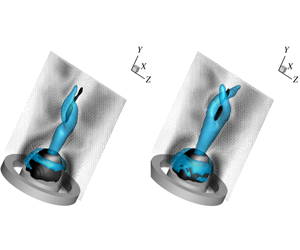Published online by Cambridge University Press: 26 November 2019

In this paper, we study the shape and dynamics of helical coherent structures found in the flow field of an annular swirling jet undergoing vortex breakdown. The flow field is studied by means of time-resolved tomographic particle image velocimetry measurements. The obtained flow fields are analysed using both classic and spectral proper orthogonal decomposition. Despite the simple geometrical set-up of the annular jet, the flow field is very complex. Two distinct large-scale helical flow structures are identified: a single and a double helix, both co-rotating with the swirl direction, and it is revealed that these structures are not higher harmonics of each other. The structures have a relatively low energy content which makes it hard to separate them from other dynamics of the flow field, notably turbulent motions. Because of this, classic proper orthogonal decomposition fails to identify both structures properly. Spectral proper orthogonal decomposition, on the other hand, allows them to be identified accurately when the filter size is set at around eight times the precession period. The precession frequencies of the single and double helices correspond to Strouhal numbers of 0.273 and  $0.536\pm 0.005$, respectively. A global stability analysis of the mean flow field shows that these structures correspond to two separate global modes. The precessing frequencies obtained by the stability analysis and the related spatial structures match very well with the experimental observations. The current work extends our knowledge on turbulent vortex breakdown and on mean field global stability theory in general. It leads to the following conclusions. Firstly, single- and double-helix vortex breakdown are both manifestations of global modes. Previous studies have shown that both
$0.536\pm 0.005$, respectively. A global stability analysis of the mean flow field shows that these structures correspond to two separate global modes. The precessing frequencies obtained by the stability analysis and the related spatial structures match very well with the experimental observations. The current work extends our knowledge on turbulent vortex breakdown and on mean field global stability theory in general. It leads to the following conclusions. Firstly, single- and double-helix vortex breakdown are both manifestations of global modes. Previous studies have shown that both  $m=1$ and
$m=1$ and  $m=2$ modes can coexist in swirling jets. However, the
$m=2$ modes can coexist in swirling jets. However, the  $m=2$ mode has been identified as a second harmonic of the first mode, while this study identifies both as two independent global modes. Secondly, this work shows that the simultaneous occurrence of multiple helical global modes is possible within a turbulent flow and their shapes and frequencies are very well predicted by mean field stability analysis. The latter finding is of general interest as it applies to a wide class of fluid problems dominated by multiple oscillatory structures.
$m=2$ mode has been identified as a second harmonic of the first mode, while this study identifies both as two independent global modes. Secondly, this work shows that the simultaneous occurrence of multiple helical global modes is possible within a turbulent flow and their shapes and frequencies are very well predicted by mean field stability analysis. The latter finding is of general interest as it applies to a wide class of fluid problems dominated by multiple oscillatory structures.